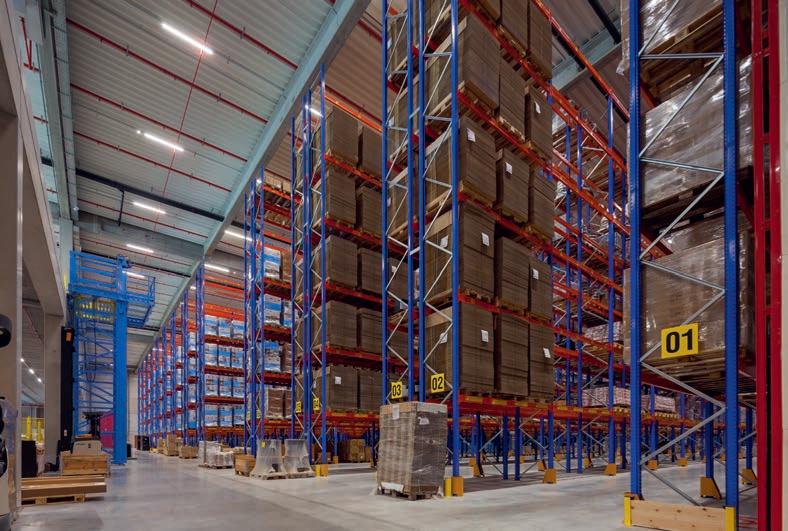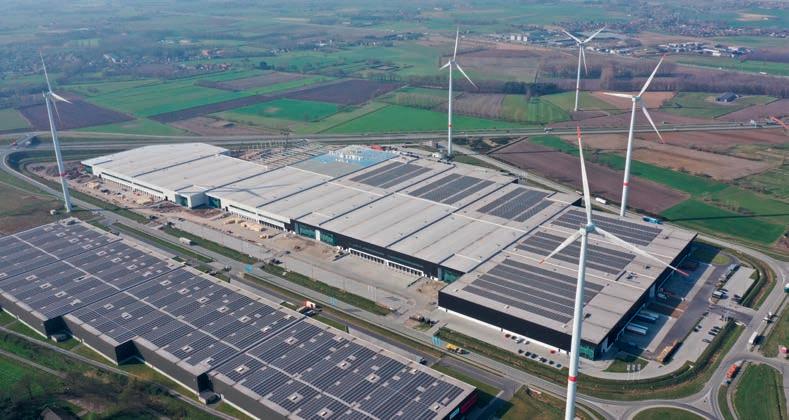
4 minute read
Heylen Warehouses’ Ghent Logistics Campus Nearing
Nearing completion
Heylen Warehouses’ Ghent Logistics Campus
Photo courtesy of Limit Fotografe.
Heylen Warehouses had cause for celebration at the start of April: with the installation of the last concrete wall panel the Ghent Logistic Campus in RiemeNoord, one of the logistic hotspots in the Belgian part of North Sea Port, entered the fnal phase of the construction works. For the logistics real estate developer the project is a major showcase.
Less than two years after the offcial launch of the building process, the futureproof logistic complex – the largest undertaking of this kind so far in Belgium for the group – is nearing completion. The last two units (out of fourteen) with a combined surface of 23,000m² should be ready respectively by the end of June and the end of August. No small feat for a project aiming at creating 150,000m² of state-of-the-art distribution and storage capacity on a 250,000m² plot of land.
Strategic choice
When Heylen effectively started building in June 2020, the pandemic provoked by the coronavirus outbreak was still at its high point and Belgium was in lock-down. It might have looked like the company was taking chances. But the project proved to be COVID-proof, as Business Development Manager Danaë Stove explains. “Taking a calculated risk is part of our entrepreneurial spirit. Looking back, we have no reason whatsoever to regret the decision to build a logistical platform of this size on this location. We were one of the frst parties to venture into this area and we started building before any frm contract was signed. But we were confdent that this strategic choice would turn out right. And so it did.” “Two major clients have already taken their quarters in the complex. The omnichannel retail platform Connect+ started out in September last year at 20,000m² and hires 30,000m² at this moment. Eltra, a leading supplier of electrical do-it-yourself equipment, is still building up volumes, but is in for another 20,000m². These companies perfectly match the profle we are aiming at, namely customers who start out at this kind of level but have the potential to grow further.”
Sustainability and second-life principle
The large-scale logistics complex consists of fourteen separate units covering 8,200 to 14,800m² each (not counting the mezzanines for added-value activities and the built-to-suit offce space). They are equipped with one loading dock per 1,000m² and one ground-level gate per unit. True to the ‘campus’ philosophy of the developer, these units can be connected to each other in every direction to meet the evolving demand of the customers in a fexible way, by enlarging or reducing the space they are allocated to ft their needs. “The units share far-reaching technical specifcations and are delivered ready-to-use. They are built to meet the BREEAM standards (Building Research Establishment Environmental Assessment Method) for maximal sustainability and minimal ecological impact. The applications are numerous, going from led-lighting, solar panels on the roof and green energy to a
thorough site and waste management, attention for health and well-being of employees, rain water recuperation, ecological land use, etc. The building has also been conceived according to the second-life principle, meaning consideration has been given from the start to a possible future use for other kinds of clients, fows, and logistical processes. The buildings we invest in today, must be able to serve other purposes tomorrow. They need to be future-proof in terms of quality, functionality, and fexibility. On top of all that they are tailored to our customers, from the size of the mezzanines and offces to the number of parking spots for their employees, the availability of charging stations for electrical vehicles, and so on.” At the Ghent Logistics Campus, Heylen Warehouses added one extra advantage: with their clear stacking height of 13.7m, they allow for one more layer of pallets, translating into approximately 15 to 17% additional storage capacity (compared to former height of 12.2m). “To us, this is the new standard. Every metre counts.”

Multimodality
Flexibility is also key when it comes to transportation. RiemeNoord is easily accessible by road and close to major highways, but the Kluizendok with its strong connections to rail and water is just a short ride away. “We are keen to develop our projects at locations offering multimodal opportunities such as these. Of course, the choice to use them rests with our clients. Generally, nowadays a lot of logistical fows still move by truck. However, an increasing number of companies is considering a modal shift by reorganising their supply chains and distribution in a more sustainable way.” At the launch of the project, the prospect of 500 jobs for the whole Logistics Campus was formulated. “It all depends on the activities which will be deployed here, of course, but we should reach that target, if only because so far they have a strong link to labour-intensive commerce”, Ms Stove says. Heylen Warehouses stands ready to look at other opportunities in North Sea Port, she adds. “We have developed a very fne and
Business Development Manager Danaë Stove.
supportive collaboration with the port, and North Sea Port is a perfect location. But space for projects like the Ghent Logistic Campus is becoming pretty scarce in Belgium, and we are not the only player on the pitch. The competition promises to be ferce.”
I. HEYLENWAREHOUSES.COM











